The University of the West Indies-Seismic Research Centre Volcano Monitoring Network: Evolution since 1953 and Challenges in Maintaining a State-of-the-Art Network in a Small Island Economy
Abstract
:1. Introduction
- monitor both earthquakes and volcanoes and, since the late 1990s, tsunamis in the Commonwealth Eastern Caribbean;
- conduct a continuous program of volcanic and seismic hazard assessment in all contributing countries;
- liaise with 11 separate governments of countries which host 17 of the 21 known, live volcanoes in the Lesser Antilles;
- carry out education and outreach activities and provide consultancy services.
2. Geological Context of the Lesser Antilles Volcanic Arc
3. 65 Years of Seismic Monitoring
3.1. 1953–2005 Period: Analog and Hybrid Seismic Monitoring Network
3.1.1. Analog Phase: 1953–1980
3.1.2. Hybrid-Sytem: 1980–2005
3.2. 2006-to Present: A Fully Digital Operating Seismic Network
4. Complementary Monitoring Networks
4.1. Ground Deformation Network
4.2. Geochemistry Monitoring of Geothermal Systems
4.3. Ocean Bottom Mapping for Volcano Monitoring Purpose
5. Challenges and Solutions
6. Conclusions
Author Contributions
Funding
Acknowledgments
Conflicts of Interest
Abbreviations
| ADSL | Asymmetric Digital Subscriber Line |
| CPACC | Caribbean Planning for Adaptation to Global Climate Change |
| COCONet | Continuously Operating Caribbean GPS Observational Network of UNAVCO |
| CU | Caribbean Network (USGS) |
| FDSN | International Federation of Digital Seismograph Networks |
| FUNVISIS | Fundación Venezolana de Investigaciones Sismológicas |
| cGPS | Continuous Global Positioning System |
| GEBCO | The General Bathymetric Chart of the Oceans |
| GNSS | Global Navigation Satellite System |
| GSN | Global Seismic Network |
| InSAR | Interferometric Synthetic Aperture Radar |
| ICG | Intergovernmental Coordination Group |
| IOC-UNESCO | Intergovernmental Oceanographic Commission of UNESCO |
| IPGP | Institut de Physique du Globe de Paris |
| KeJ | Kick-’em-Jenny Submarine Volcano |
| KNMI | Koninklijk Nederlands Meteorologisch Instituut |
| MDPI | Multidisciplinary Digital Publishing Institute |
| MV | Montserrat Volcano Observatory |
| NA | Caribbean Netherlands Seismic Network |
| NOAA | National Oceanic and Atmospheric Administration |
| NSF | National Science Foundation |
| PRSN | Puerto-Rico Seismic Network |
| SRC | Seismic Research Centre |
| SRU | Seismic Research Unit |
| TR | UWI-SRC Eastern Caribbean Network |
| UCAR | University Corporation for Atmospheric Research |
| UHF | Ultra High Frequency |
| UNAVCO | University NAVSTAR Consortium (former name of the non-profit university governed consortium) |
| UNESCO | The United Nations Educational, Scientific and Cultural Organization |
| USAID | The United States Agency for International Development |
| USGS | The United State Geological Survey |
| UWI | The University of the West Indies |
| VE | Red Sismologica Nacional con Apertura Continental |
| VSAT | Very Small Apperture Terminal |
| WI | West Indies Network (IPGP, UWI-SRC) |
References
- Boudon, G.; Le Friant, A.; Villemant, B.; Viode, J.P. Martinique. In Volcanic Hazard Atlas of the Lesser Antilles; Lindsay, J.M., Robertson, R.E.A., Shepherd, J.B., Ali, S., Eds.; Seismic Research Unit, The University of the West Indies: St. Augustine, Trinidad and Tobago, 2005; pp. 128–146. [Google Scholar]
- Lacroix, A. La Montagne Pelée et ses Eruptions; Masson: Paris, France, 1904; pp. 1–662. [Google Scholar]
- Lynch, L.; Ambeh, W.; Robertson, R.; Latchman, J.; Bridgemohan, M. A medium-sized seismograph network in a challenging environment. Geofís. Int. 1996, 35, 213–226. [Google Scholar]
- Latchman, J.; Lynch, L.; Edwards, S. 60 years of monitoring volcanic and earthquake activity in the English-speaking Eastern Caribbean. Caribb. Geogr. 2012, 17, 3–17. [Google Scholar]
- Latchman, J. Seismic Potential of the S.W. Tobago Fault System. Master’s Thesis, The University of the West Indies, St. Augustine, Trinidad and Tobago, 1998. [Google Scholar]
- Lindsay, J.M.; Shepherd, J.B.; Wilson, D. Volcanic and scientific activity at Kick’em Jenny submarine volcano 2001–2002: Implications for volcanic hazards in the Southern Grenadines, Lesser Antilles. Nat. Hazards 2005, 34, 1–24. [Google Scholar] [CrossRef]
- Lindsay, J.M.; Robertson, R.E.A.; Shepherd, J.B.; Ali, S. (Eds.) Volcanic Atlas of the Lesser Antilles; Seismic Research Unit, The University of the West Indies: St. Augustine, Trinidad and Tobago, 2005; pp. 1–279. [Google Scholar]
- DeMets, C.; Jansma, P.E.; Mattioli, G.S.; Dixon, T.H.; Farina, F.; Bilham, R.; Calais, E.; Mann, P. GPS geodetic constraints on Caribbean-North America plate motion. Geophys. Res. Lett. 2000, 27, 437–440. [Google Scholar] [CrossRef]
- Speed, R.; Smith-Horowitz, P.; Perch-Nielsen, K.; Saunders, J.; Sanfilippo, A. Southern Lesser Antilles arc platform: Pre-Late Miocene stratigraphy, structure, and tectonic evolution. Geol. Soc. Am. Spec. Pap. 1993, 277, 98. [Google Scholar]
- Weber, J.; Dion, T.H.; DeMets, C.; Ambeh, W.B.; Jansma, P.; Mattioli, G.; Saleh, J.; Sella, G.; Bilham, R.; Perez, O. GPS estimate of relative motion between the Caribbean and the South American plates, and geologic implication for Trinidad and Venezuela. Geology 2001, 29, 75–78. [Google Scholar] [CrossRef]
- Feuillet, N.; Beauducel, F.; Tapponnier, P. Tectonic context of moderate to large historical earthquakes in the Lesser Antilles and mechanical coupling with volcanoes. J. Geophys. Res. 2011, 116, 1–26. [Google Scholar] [CrossRef]
- Wadge, G.; Shepherd, J.B. Segmentation of the Lesser Antilles subduction zone. Earth Planet. Sci. Lett. 1984, 71, 297–304. [Google Scholar] [CrossRef]
- Wadge, G. The dykes and structural setting of the volcanic front in the Lesser Antilles island arc. Bull. Volcanol. 1986, 48, 349–372. [Google Scholar] [CrossRef]
- Sykes, L.R.; McCann, W.R.; Kafka, A.L. Motion of the Caribbean plate during the last 7 millions years and implications for earlier Cenozoic movements. J. Geeophys. Res. 1982, 87, 10656–10676. [Google Scholar] [CrossRef]
- Bouysse, P.; Westercamp, D. Subduction of Atlantic aseismic ridges and Late Cenozoic evolution of the Lesser Antilles island arc. Tectonophysics 1990, 175, 349–380. [Google Scholar] [CrossRef]
- Beckles, D.; Shepherd, J.; Aspinall, W. The Wurst machine: A programme for estimating hypocentral coordinates of regional earthquakes. In Proceedings of the First Meeting of the Asociacion Ibero-Latino Americana de Geofisica; Asociacion Ibero-Latino Americana de Geofisica: Caracas, Venezuela, 1977; pp. 95–125. [Google Scholar]
- Beckles, D.; Shepherd, J.; Aspinall, W. The “Soufrière” system: PC-based instrumentation for acquiring and processing data from seismograph networks (ext. Abs). Tectonophysics 1992, 209, 47–49. [Google Scholar] [CrossRef]
- The Intergovernmental Oceanographic Commission of UNESCO. One Planet. One Ocean; IOC Brochure 2017-1; IOC: Paris, France, 2017; 68p.
- McMillan, J.R. Methods of Installing United States National Seismographic Network (USNSN) Stations—A Construction Manual; USGS Open-File Report; USGS: Reston, VA, USA, 2002.
- Anglade, A.; Lemarchand, A.; Saurel, J.M.; Clouard, V.; Bouin, M.P.; De Chabalier, J.B.; Tait, S.; Brunet, C.; Nercessian, A.; Beauducel, F.; et al. Significant technical advances in broadband seismic stations in the Lesser Antilles. Adv. Geosci. 2015, 40, 43–50. [Google Scholar] [CrossRef] [Green Version]
- Havskov, J.; Ottemoller, L. SeisAn earthquake analysis software. Seismol. Res. Lett. 1999, 70, 532–534. [Google Scholar] [CrossRef]
- Mogi, K. Relations between the eruptions of various volcanoes and the deformations of the ground surface around them. Bul. Earthq. Res. Inst. 1958, 36, 99–134. [Google Scholar]
- Dzurizin, D. Volcano Deformation; Springer: Berlin, Germany, 2007. [Google Scholar] [CrossRef]
- David, J. Internal Report about the Ground Deformation campaign in St Vincent 5–27 September 2001; Internal Report; Seismic Research Unit, The University of the West Indies: St. Augustine, Trinidad and Tobago, 2001. [Google Scholar]
- Fiske, R.S.; Shepherd, J. Twelve years of ground-tilt measurements on the Soufriere of St. Vincent, 1977–1989. Bull. Volcanol. 1990, 52, 227. [Google Scholar] [CrossRef]
- Fiske, R.S.; Shepherd, J. Deformation Studies on Soufriere, St. Vincent, Between 1977 and 1981. Science 1982, 216, 1125–1126. [Google Scholar] [CrossRef] [PubMed]
- Braun, J.; Mattioli, G.S.; Calais, E.; Carlson, D.; Dixon, T.H.; Jackson, M.E.; Kursinski, E.R.; Mora-Paez, H.; Miller, M.M.; Pandya, R.; et al. Focused study of interweaving hazards across the Caribbean. EOS Trans. AGU 2012, 93, 89. [Google Scholar] [CrossRef]
- Ryan, G.; Hamling, I.J.; Pascal, K. Measuring Volcano Related Ground Deformation in the Eastern Caribbean; Interim Report ra6 (for Japan Aerospace Exploration Agency); The University of the West Indies, Seismic Research Center: St. Augustine, Trinidad and Tobago, 2018; p. 16. [Google Scholar]
- Yu, C.; Li, Z.; Penna, N. Interferometric synthetic aperture radar atmospheric correction using a gps-based iterative tropospheric decomposition model. Remote Sens. Environ. 2018, 204, 109–121. [Google Scholar] [CrossRef]
- Robson, G.; Willmore, P. Some heat measurements in West Indian soufrieres. Bull. Volcanol. 1955, 17, 13. [Google Scholar] [CrossRef]
- Joseph-Ramdan, E. Geochemistry of Geothermal Systems in St Lucia and Dominica, Lesser Antilles: Implications for Volcanic Monitoring. Ph.D Thesis, The University of the West Indies, St. Augustine, Trinidad and Tobago, 2008; 240p. [Google Scholar]
- Joseph, E.; Robertson, R. Sampling of Geothermal Features in St. Lucia and Dominica 3–9 November 2003; Internal Report; Seismic Research Unit, The University of the West Indies: St. Augustine, Trinidad and Tobago, 2003. [Google Scholar]
- Lindsay, J.; Smith, A.; Roobol, M.; Stasiuk, M. Dominica. In Volcanic Hazard Atlas of the Lesser Antilles; Lindsay, J.M., Robertson, R.E.A., Shepherd, J.B., Ali, S., Eds.; Seismic Research Unit, The University of the West Indies: St. Augustine, Trinidad and Tobago, 2005; pp. 2–47. [Google Scholar]
- Joseph, E. Sampling of Geothermal Features in Grenada and St. Vincent 18–21 June 2003; Internal Report; Seismic Research Unit, The University of the West Indies: St. Augustine, Trinidad and Tobago, 2003. [Google Scholar]
- Robertson, R. Grenada. In Volcanic Hazard Atlas of the Lesser Antilles; Lindsay, J.M., Robertson, R.E.A., Shepherd, J.B., Ali, S., Eds.; Seismic Research Unit, The University of the West Indies: St. Augustine, Trinidad and Tobago, 2005; pp. 49–66. [Google Scholar]
- Lindsay, J. Report on Visit to Sample Features in Geothermal Areas of St. Kitts and Nevis, 18–22 April 2001; Internal Report; Seismic Research Unit, The University of the West Indies: St. Augustine, Trinidad and Tobago, 2003. [Google Scholar]
- Robertson, R. St. Kitts. In Volcanic Hazard Atlas of the Lesser Antilles; Lindsay, J.M., Robertson, R.E.A., Shepherd, J.B., Ali, S., Eds.; Seismic Research Unit, The University of the West Indies: St. Augustine, Trinidad and Tobago, 2005; pp. 202–217. [Google Scholar]
- Lindsay, J. St. Lucia. In Volcanic Hazard Atlas of the Lesser Antilles; Lindsay, J.M., Robertson, R.E.A., Shepherd, J.B., Ali, S., Eds.; Seismic Research Unit, The University of the West Indies: St. Augustine, Trinidad and Tobago, 2005; pp. 218–238. [Google Scholar]
- Robertson, R. St. Vincent. In Volcanic Hazard Atlas of the Lesser Antilles; Lindsay, J.M., Robertson, R.E.A., Shepherd, J.B., Ali, S., Eds.; Seismic Research Unit, The University of the West Indies: St. Augustine, Trinidad and Tobago, 2005; pp. 240–261. [Google Scholar]
- Joseph, E.; Fournier, N.; Lindsay, J.; Fischer, T. Gas and water geochemistry of geothermal systems in Dominica, Lesser Antilles island arc. J. Volcanol. Geother. Res. 2011, 206, 1–14. [Google Scholar] [CrossRef]
- Joseph, E.; Fournier, N.; Lindsay, J.; Robertson, R.; Beckles, D. Chemical and isotopic characteristics of geothermal fluids from Sulphur Springs, Saint Lucia. J. Volcanol. Geother. Res. 2013, 254, 23–36. [Google Scholar] [CrossRef]
- Joseph, E.; Beckles, D.; Cox, L.; Jackson, V.; Alexander, D. An evaluation of ambient sulphur dioxide concentrations from passive degassing of the Sulphur Springs, Saint Lucia geothermal system: Implications for human health. J. Volcanol. Geother. Res. 2015, 304, 38–48. [Google Scholar] [CrossRef]
- Clouard, V.; Bonneville, A. Submarine Landslides in French Polynesia. In Oceanic Hotspots: Intraplate Submarine Magmatism and Tectonism; Hekinian, R., Cheminée, J.L., Stoffers, P., Eds.; Springer: Berlin/Heidelberg, Germany, 2004; pp. 209–238. [Google Scholar] [CrossRef]
- Chadwick, W.W., Jr.; Wright, I.C.; Schwarz-Schampera, U.; Hyvernaud, O.; Reymond, D.; de Ronde, C.E.J. Cyclic eruptions and sector collapses at Monowai submarine volcano, Kermadec arc: 1998–2007. Geochem. Geophys. Geosyst. 2008, 9, Q10014. [Google Scholar] [CrossRef]
- Dondin, F.; Lebrun, J.F.; Kelfoun, K.; Fournier, N.; Randrianasolo, A. Sector collapse at Kick ’em Jenny submarine volcano (Lesser Antilles)—Numerical simulation and mass flow behaviour implications. Bull. Volcanol. 2012, 74, 595–607. [Google Scholar] [CrossRef]
- Allen, R.; Berry, C.; Henstock, T.; Collier, J.; Dondin, F.Y.; Rietbrock, A.; Latchman, J.; Robertson, R. 30 Years in the Life of an Active Submarine Volcano: A Time-Lapse Bathymetry Study of the Kick-‘em-Jenny Volcano, Lesser Antilles. Geochem. Geophys. Geosyst. 2018. [Google Scholar] [CrossRef]
- Bouysse, P.; Mascle, A.; Mauffret, A.; Mercier de Lepinay, B.; Jany, I.; Leclerc-Vanhoeve, A.; Montjarret, M.C. Reconnaissance de structures tectoniques et volcaniques sous-marines de l’arce recent des Petites Antilles (Kick ’em Jenny, Qualibou, Montagne Pelée, Nord-Ouest de la Guadeloupe). Mar. Geol. 1988, 81, 261–287. [Google Scholar] [CrossRef]
- Watlington, R.; Wilson, W.; Johns, W.; Nelson, C. Updated bathymetric survey of Kick-’em-Jenny submarine volcano. Mar. Geophys. Res. 2002. [Google Scholar] [CrossRef]
- Lindsay, J.M.; Shepherd, J.B. Kick ’em Jenny and Île de Caille. In Volcanic Hazard Atlas of the Lesser Antilles; Lindsay, J.M., Robertson, R.E.A., Shepherd, J.B., Ali, S., Eds.; Seismic Research Unit, The University of the West Indies: St. Augustine, Trinidad and Tobago, 2005; pp. 105–125. [Google Scholar]
- Dondin, F.Y.; Heap, M.; Robertson, R.; Dorville, J.F.; Carey, S. Flank instability assessment at Kick-’em-Jenny submarine volcano (Grenada, Lesser Antilles): A multidisciplinary approach using experiments and modeling. Bull. Volcanol. 2017, 79, 5. [Google Scholar] [CrossRef]
- Roman, C.; Inglis, G.; Vaughn, I.; Smart, C.; Dansereau, D.; Bongiorno, D.; Johnson-Roberson, M.; Bryson, M. New tools and methods for precision seafloor mapping. Oceanography 2013, 26, 10–15. [Google Scholar]
- Carey, S.; Olsen, R.; Bell, K.; Ballard, R.; Dondin, F.; Roman, C.; Smart, C.; Lilley, M.; Lupton, J.; Seibel, B.; et al. Hydrothermal venting and mineralization in the crater of Kick’em Jenny submarine volcano, Grenada (Lesser Antilles). Geochemistry 2016. [Google Scholar] [CrossRef]
- Symithe, S.; Calais, E.; Chabalier, J.B.; Robertson, R.; Higgins, M. Current block motions and strain accumulation on active faults in the Caribbean. J. Geophys. Res. Solid Earth 2015, 120, 3748–3774. [Google Scholar] [CrossRef] [Green Version]
- Wessel, P.; Smith, W.H.F.; Scharroo, R.; Luis, J.; Wobbe, F. Generic Mapping Tools: Improved Version Released. Eos Trans. Am. Geophys. Union 2013, 94, 409–410. [Google Scholar] [CrossRef] [Green Version]
- The GEBCO_2014 Grid, Version 20150318. 2014. Available online: www.gebco.net (accessed on 15 October 2015).
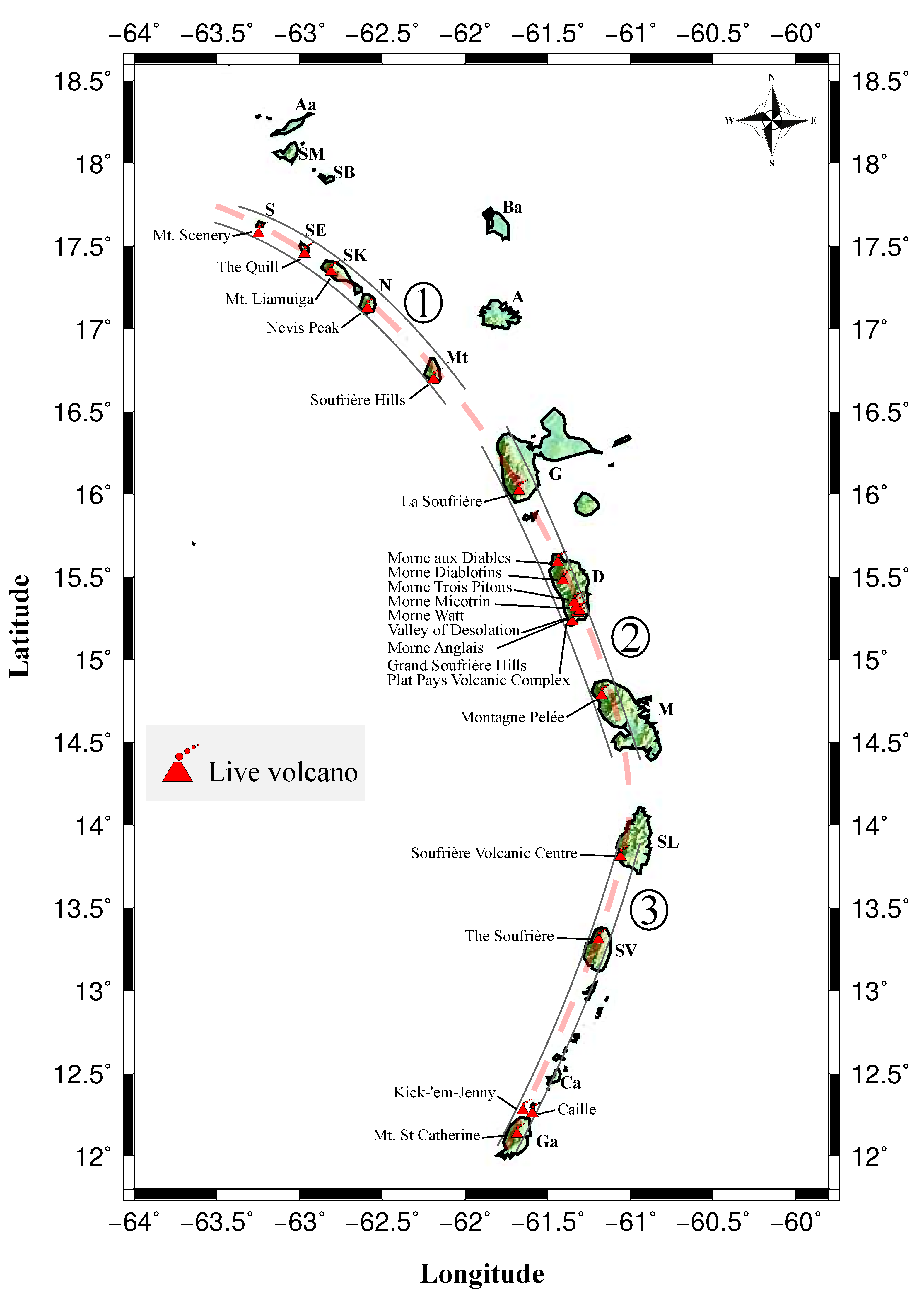


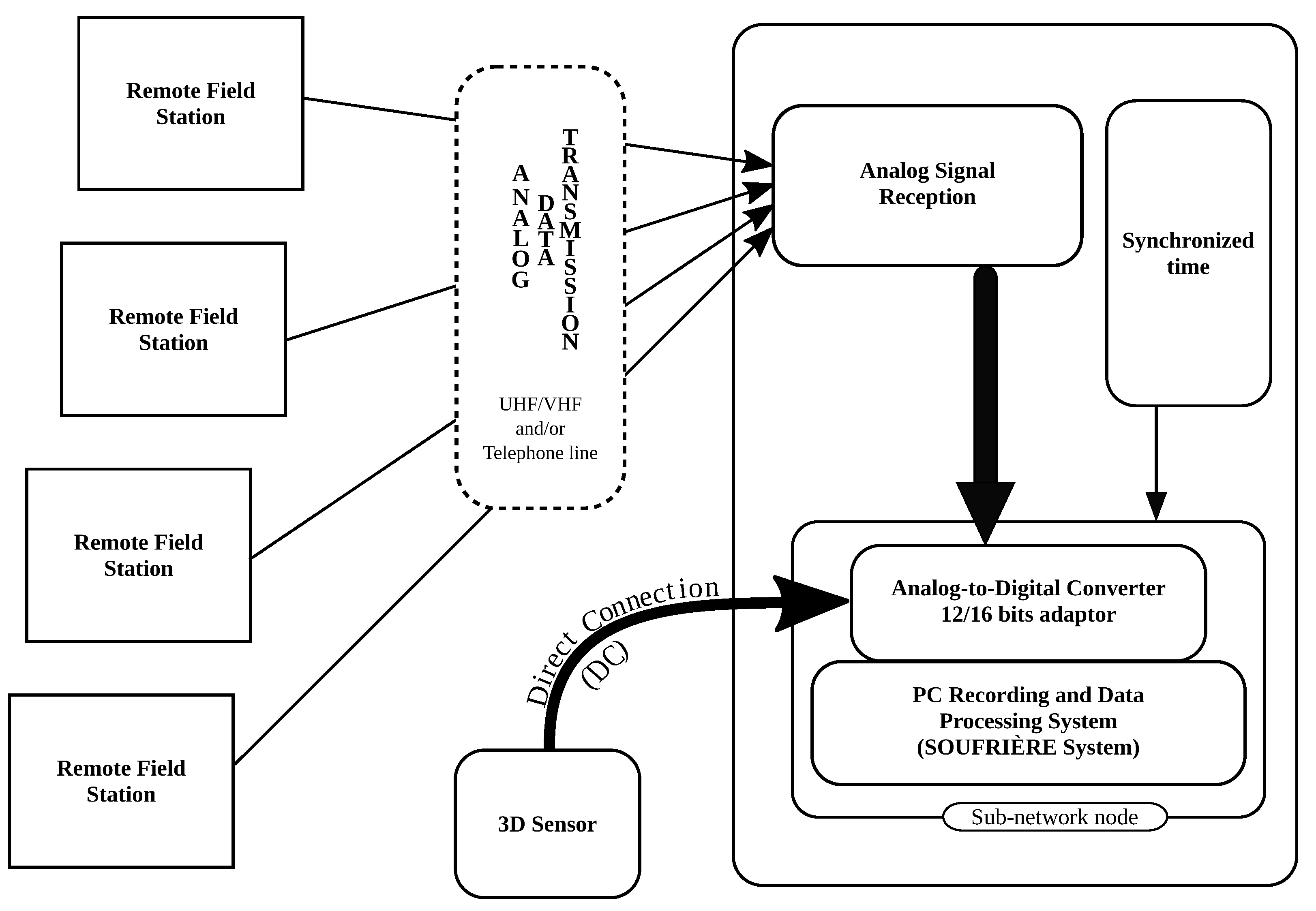
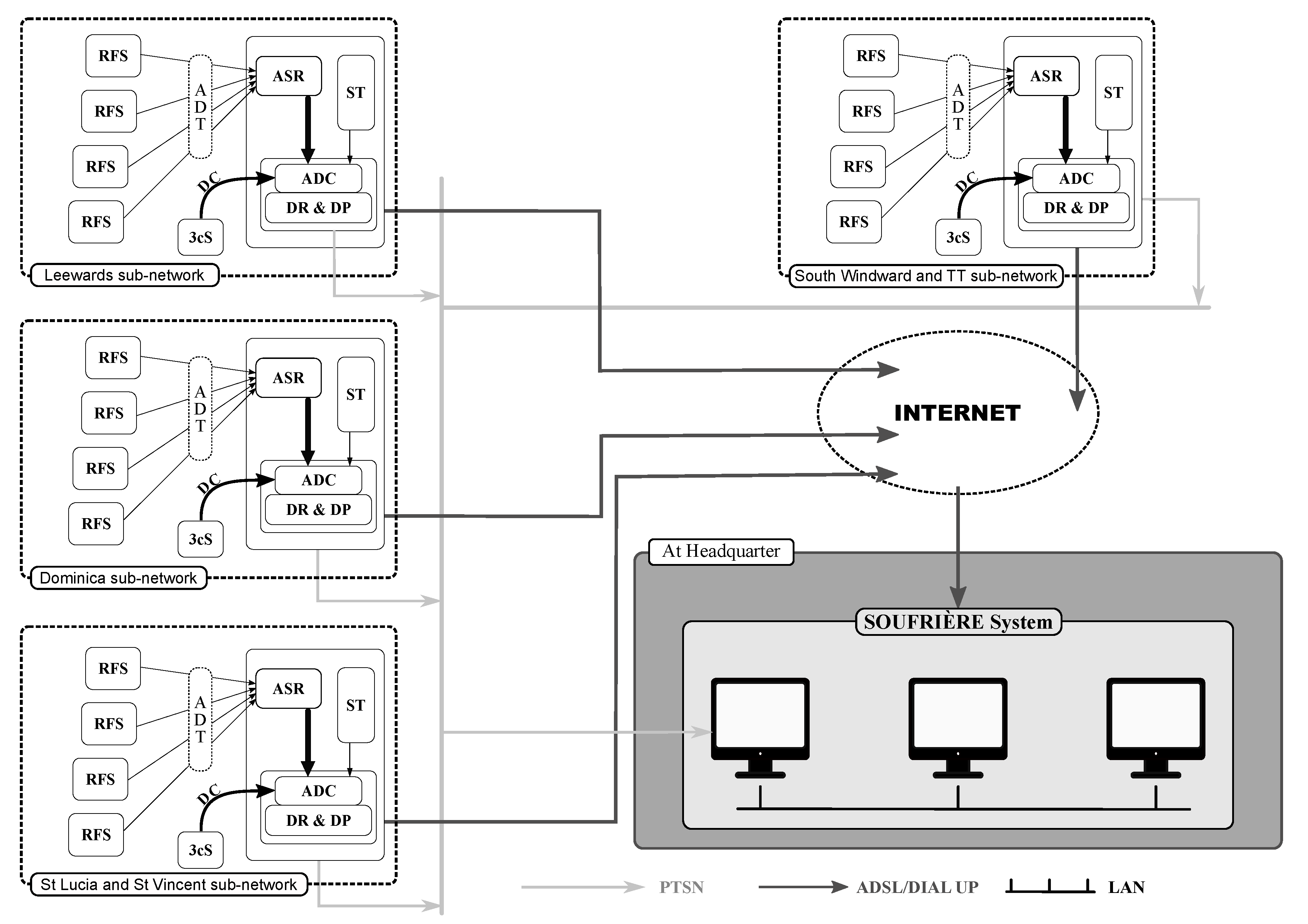


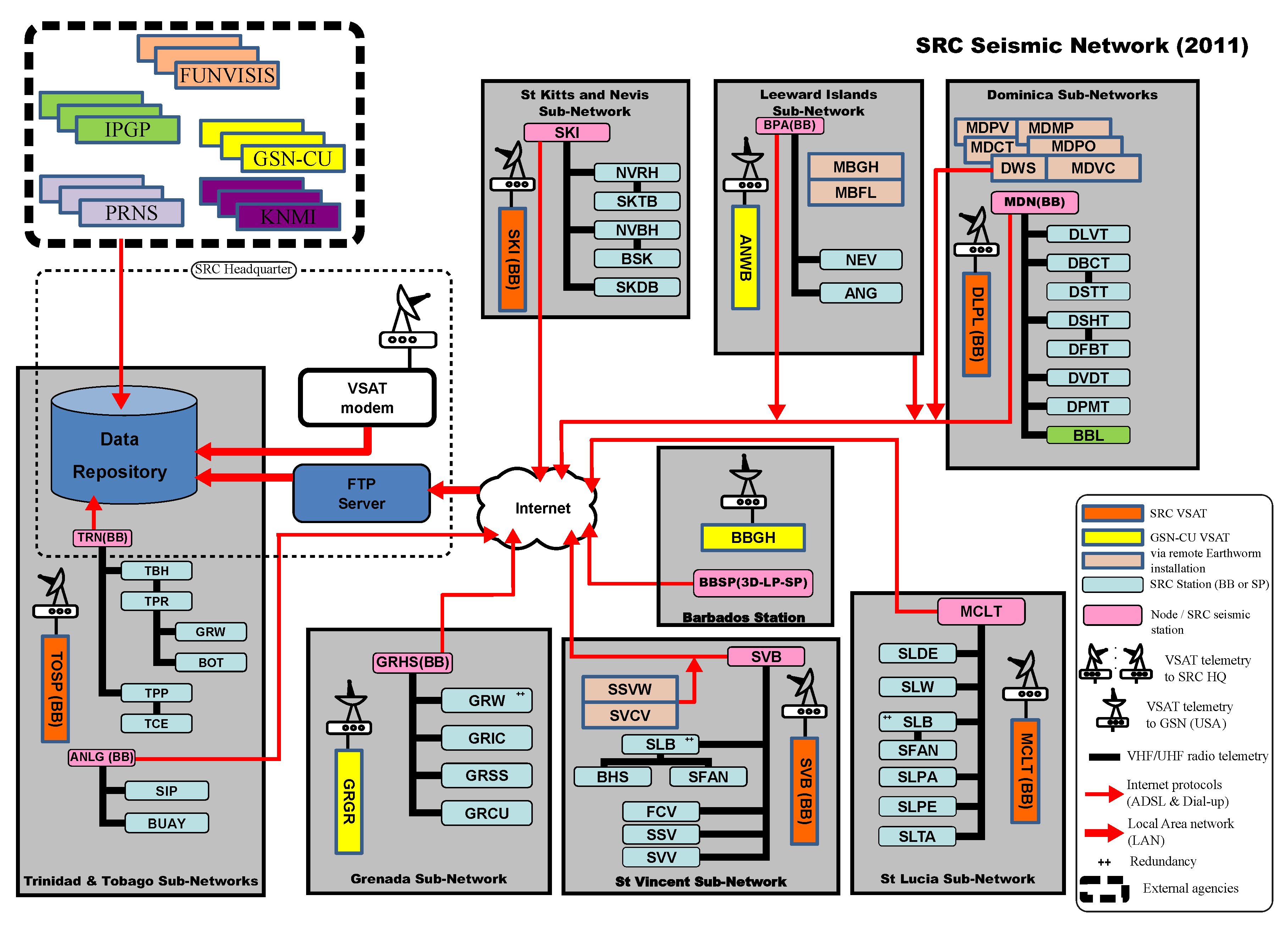
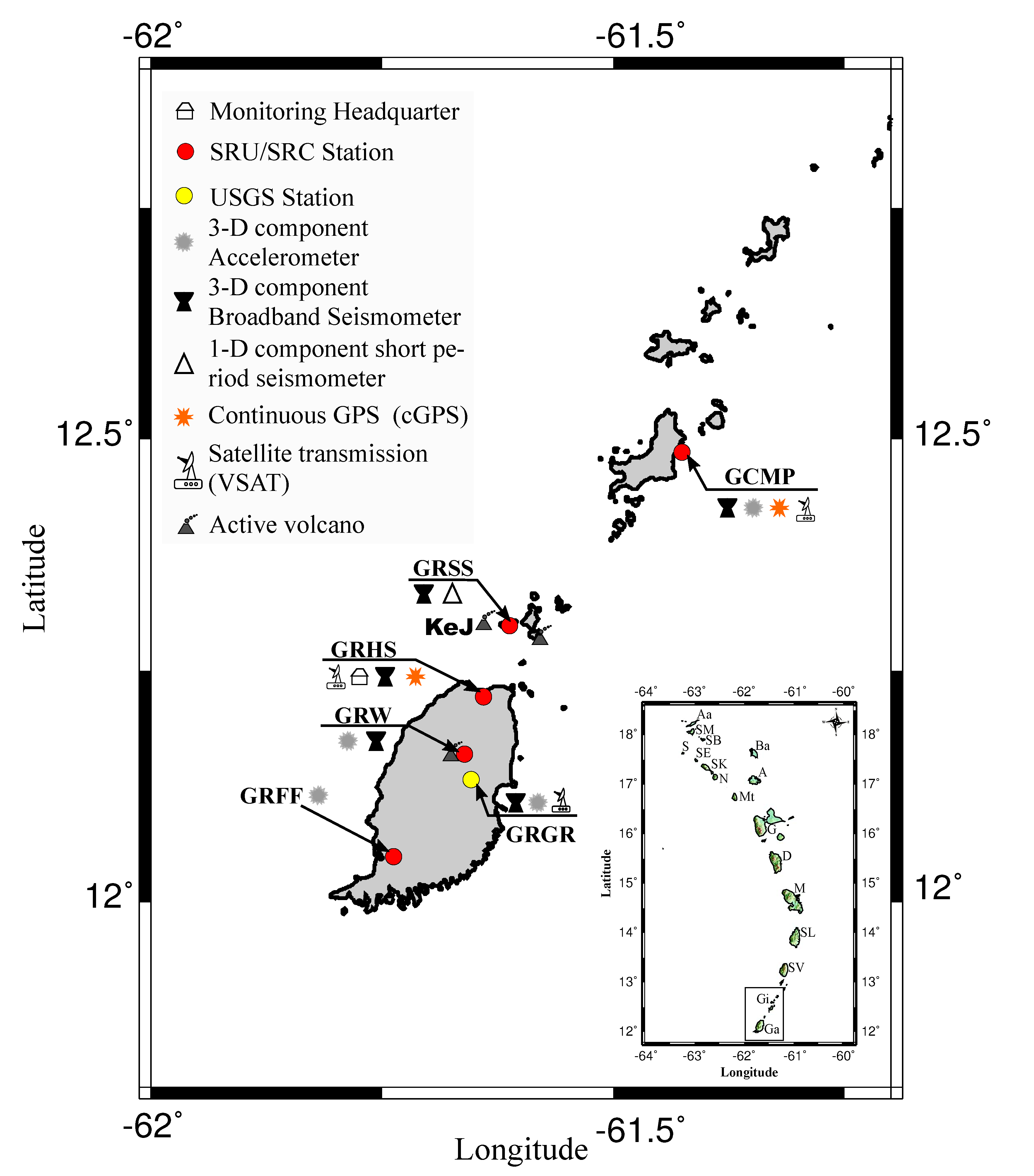
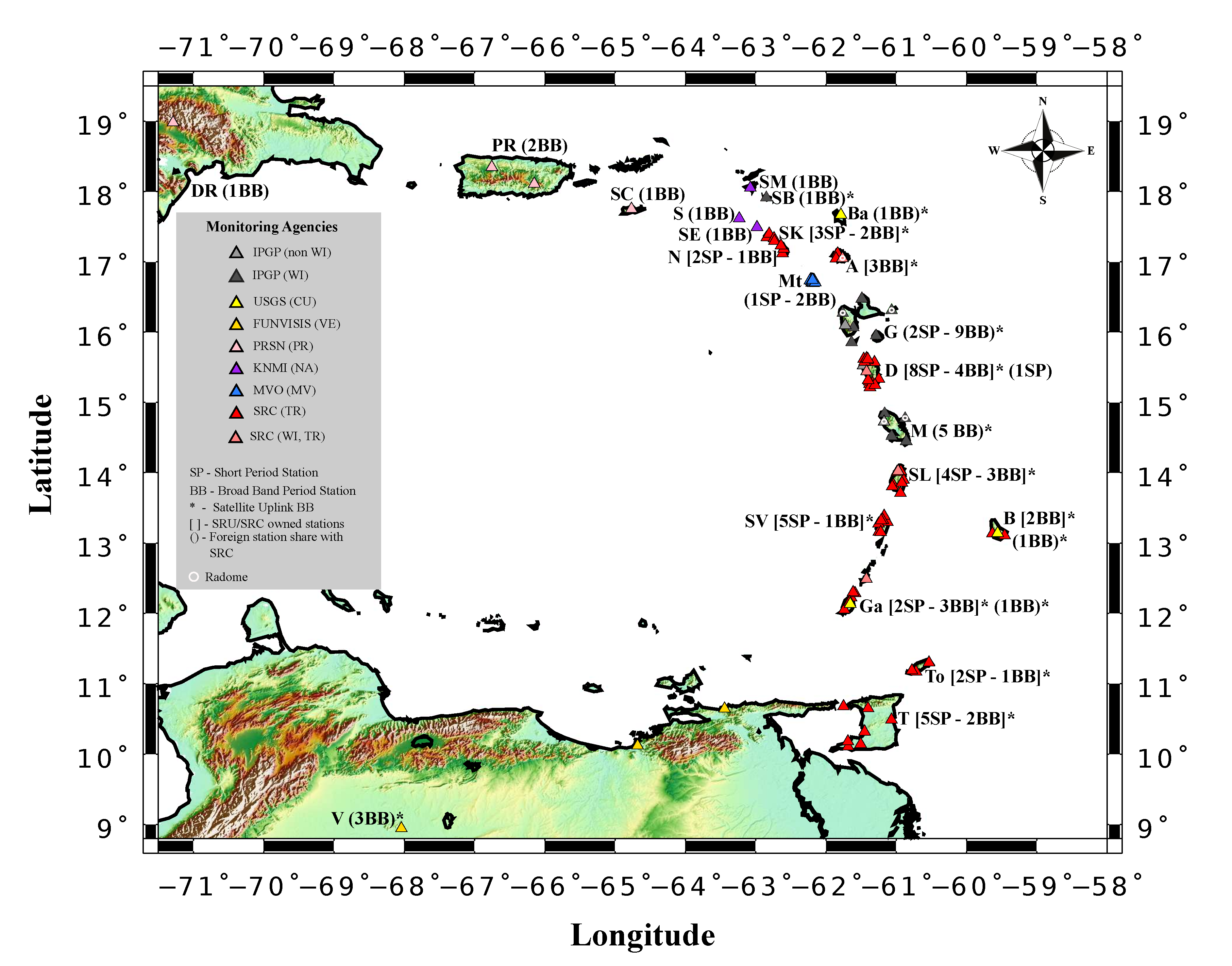

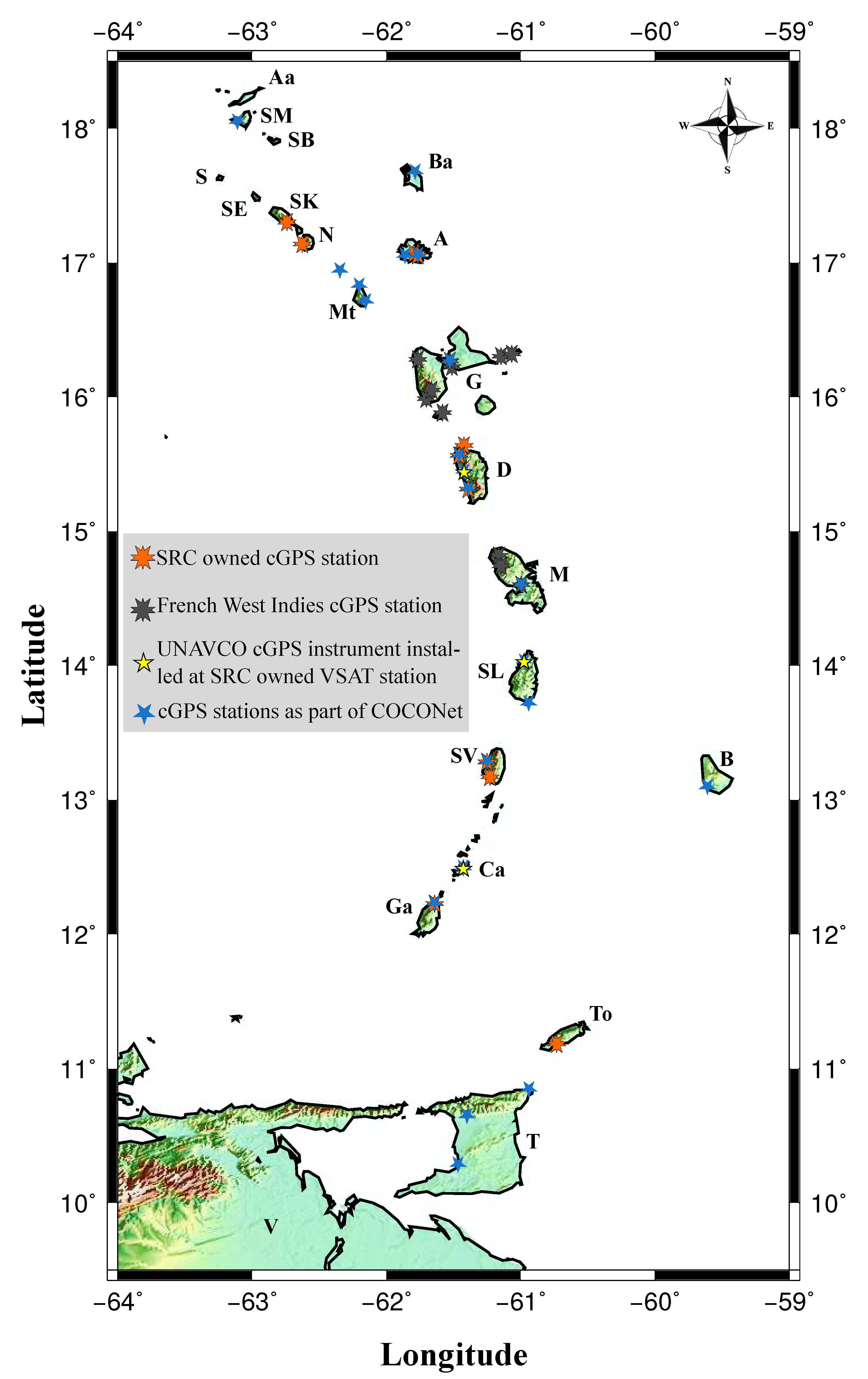
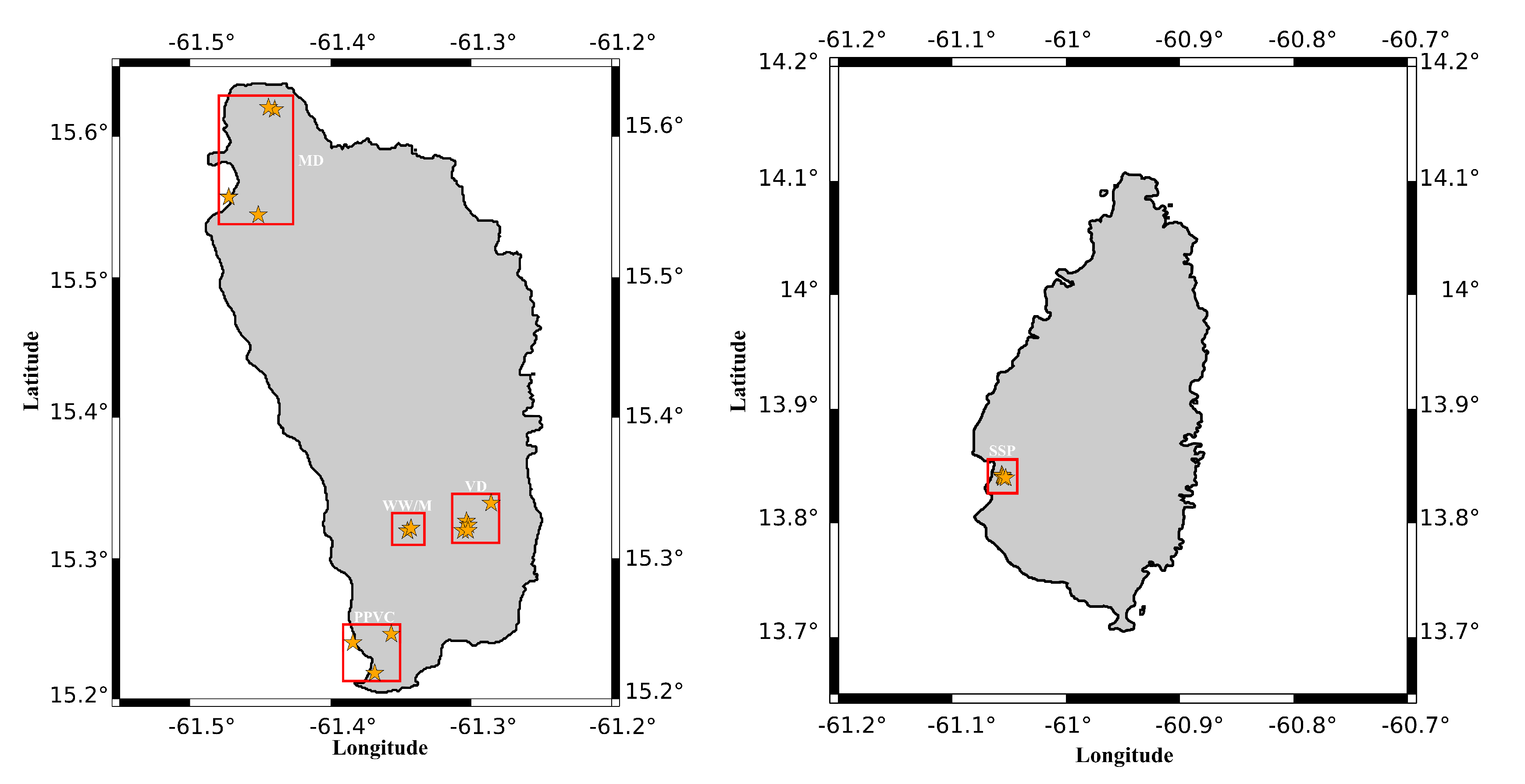
| Period of Operation | 1953–1961 | 1961–1980 | 1980–1998 | 1998–Present | 2006–Present |
|---|---|---|---|---|---|
| Technology | Analog | Hybrid | Digital | ||
| Topology | Class 1 | Class 2 | Class 3 | Class 4 | Class 5 |
© 2019 by the authors. Licensee MDPI, Basel, Switzerland. This article is an open access article distributed under the terms and conditions of the Creative Commons Attribution (CC BY) license (http://creativecommons.org/licenses/by/4.0/).
Share and Cite
Dondin, F.J.-Y.; Lynch, L.; Ramsingh, C.; Ryan, G.A.; Papadopoulous, I.; Rueppel, D.; Joseph, E.P.; Latchman, J.L.; Robertson, R.E.A.; Nath, N.; et al. The University of the West Indies-Seismic Research Centre Volcano Monitoring Network: Evolution since 1953 and Challenges in Maintaining a State-of-the-Art Network in a Small Island Economy. Geosciences 2019, 9, 71. https://doi.org/10.3390/geosciences9020071
Dondin FJ-Y, Lynch L, Ramsingh C, Ryan GA, Papadopoulous I, Rueppel D, Joseph EP, Latchman JL, Robertson REA, Nath N, et al. The University of the West Indies-Seismic Research Centre Volcano Monitoring Network: Evolution since 1953 and Challenges in Maintaining a State-of-the-Art Network in a Small Island Economy. Geosciences. 2019; 9(2):71. https://doi.org/10.3390/geosciences9020071
Chicago/Turabian StyleDondin, Frédéric J.-Y., Lloyd Lynch, Chan Ramsingh, Graham A. Ryan, Ilias Papadopoulous, Daniel Rueppel, Erouscilla P. Joseph, Joan L. Latchman, Richard E. A. Robertson, Nisha Nath, and et al. 2019. "The University of the West Indies-Seismic Research Centre Volcano Monitoring Network: Evolution since 1953 and Challenges in Maintaining a State-of-the-Art Network in a Small Island Economy" Geosciences 9, no. 2: 71. https://doi.org/10.3390/geosciences9020071
APA StyleDondin, F. J.-Y., Lynch, L., Ramsingh, C., Ryan, G. A., Papadopoulous, I., Rueppel, D., Joseph, E. P., Latchman, J. L., Robertson, R. E. A., Nath, N., Mathura, R., Balchan, A., George, S., Juman, I., Madoo, F., Manette, G., & Ramsingh, H. (2019). The University of the West Indies-Seismic Research Centre Volcano Monitoring Network: Evolution since 1953 and Challenges in Maintaining a State-of-the-Art Network in a Small Island Economy. Geosciences, 9(2), 71. https://doi.org/10.3390/geosciences9020071





